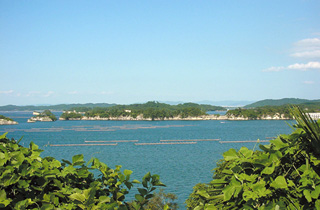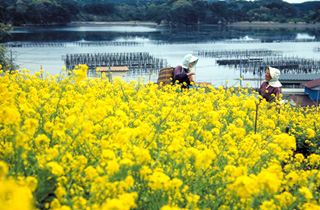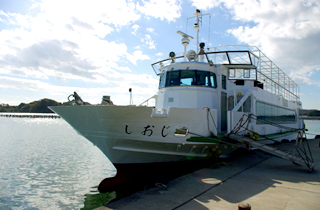
浦戸諸島(うらとしょとう)は、宮城県塩竈市の松島湾の入り口にある島嶼群の名称です。 松島の景観は、“八百八島”と呼ばれることもあるほど、浦戸諸島には島が多くあるのです。現在松島湾で、島と認められるものは230。暗礁に近いものを含めると300近い数字になるそうです。
そのうち浦戸諸島には桂島(かつらしま)、野々島(ののしま)、寒風沢島(さぶさわじま)、朴島(ほうじま)の有人島があり、馬放島、大森島など無人島で名前が分かっている島が53、の他無名の島も沢山あります。 名前の由来は松島湾(浦)の門戸からきており、外松島とも呼ばれます。
松島の風景を、陸側からではなく海側から見ることができる場所でもあり、その風景は、陸側から見る松島の雄大さに対し、女性的な風景であると表現される事もあるそうです。松島のまた違った表情をこの浦戸で見つけることができるかもしれません。
Urato Islands is the name given to a group of islands located at the mouth of Matsushima Bay in Shiogama City, Miyagi Prefecture. Matsushima’s landscape is studded with what are called “hachi hyaku hachi to” in Japanese, or “eight hundred and eight islands,” signifying the numerous islands within the archipelago. At present, there are 230 islands recognized as such in Matsushima Bay; and if nearly sunken rocks are included in the count, the number reaches to about 300.
There are four inhabited islands out of these 300 islands. They are called Katsurashima, Nonoshima, Sabusawajima and Hōjima. There are 53 desert islands with names such as Mahanashijima and Omorijima; while there are many other uninhabited, unnamed islands.
The name “Urato” is derived from the Japanese words “ura” meaning “bay,” and “to” meaning “door,” because the Urato Islands are located at the mouth or the gateway to Matsushima Bay. The islands are also called Tomatsushima, which means “outer Matsushima,” in contrast to the “inner Matsushima” islands within the bay.
Aside from land, Matsushima’s scenery can also be viewed from the sea. From land, one can experience the scenery’s expansive grandeur, while from the sea, the scenery has been described in more feminine terms. One might even find a different way of describing Matsushima upon visiting Urato.
浦戸諸島の紹介
An Introduction to the Urato Islands
- 桂島(かつらしま)
- 面積0.76㎢人口約280人。浦戸諸島4島の中で最も塩竈市内に近い島で、定期船で最初に到着する島です。桂島海水浴場が有名で夏には毎年多くの海水浴客が訪れます。桂島、石浜2つの地域があり、浦戸諸島の中では最も人口が多い島でもあり、民宿の多くは桂島にあります。毎年8月13日に行われる夏祭りの花火大会も有名で、沢山の人で賑わいます。
- Katsurashima
- Katsurashima has an area of 0.76 square kilometers and a population of about 280 people. Out of the four inhabited islands in Urato Islands, it is the closest in proximity to Shiogama City, and it is the first island where liners that regularly service the islands dock. It is famous for its beach, and in the summer, many bathers visit its shore. It is divided into two areas namely, Katsurashima and Ishihama; and among the Urato Islands, it has the most people, with most of its inns located on the Katsurashima side. It is also famous for its fireworks display held every August 13th during its summer festival, with many people enjoying this tradition.*
- 野々島(ののしま)
- 面積0.56㎢人口約100人。塩竈市の出先機関である浦戸諸島開発総合センター(愛称:ブルーセンター)、浦戸診療所、唯一の学校である浦戸第二小学校/浦戸中学校があり、浦戸諸島の行政・生活の事実上の中心となっている島です。島のいたるところに洞窟や野仏があり、夜鳴き地蔵、「椿のトンネル」などが名所となっています。 毎年8月14日に行われる、盆踊り花火大会は塩竈地域の風物詩になっています。
- Nonoshima
- Nonoshima has an area of 0.56 square kilometers and a population of about 100 people. For all intents and purposes, it is the center of daily life in the islands as it houses the only school (the Urato Second Elementary School/Urato Middle School) and the Urato medical clinic. Nonoshima is also in effect, the administrative center, as it accommodates the Urato Development Center (nicknamed the “Blue Center”), an outpost of Shiogama City. There are caves and buddha statues on fields all over the island, and the island is also known for its “tunnel of camellias,” a popular sightseeing spot. In addition, the Bon Odori** and fireworks display held every August 14th is a tradition evocative of summer in the Shiogama region.
- 寒風沢島(さぶさわじま)
- 面積1.45㎢、人口約160人。浦戸諸島最大の島です。野々島と寒風沢水道を隔てて約100mで面しているほか、東岸も鰐ヶ淵水道を隔てて「奥松島」の主要部である宮戸島に面しており、両島に挟まれるような形になっています。斎藤潤の『日本島旅紀行』 には「自給自足を実現している島」と書き表されています。
- Sabusawajima
- Sabusawajima has an area of 1.45 square kilometers and a population of about 160 people. It is the largest island in the Urato Islands. About 100 meters of the island are located across Nonoshima and faces the Sabusawa Channel; and is also positioned across the eastern coast and the Wanigafuchi Channel. It is sandwiched between Nonoshima and Miyadojima, which is the main part of Okumatsushima, a coastal area deep inside Matsushima. Author Jun Saito wrote in his book “Nihon Shima Tabi Kikou” (Traveling Japan’s Islands) that it is an island that has attained self-sufficiency.
- 朴島(ほおじま)
- 面積0.15㎢、人口約30人。浦戸諸島では最も奥にあり、最も小さな島です。島名の由来は、鳳凰が住んでいたからとも、烽火(狼煙)場があったからとも、仙台藩にまつわる宝島伝説があるからとも言われています。純粋な仙台白菜の種を採るために島中で菜の花が栽培されており、毎年ゴールデンウィークの時期になると、見事な花の風景を見ることができます。また、島内にはタブノキの原生林があり、松島湾にある知られざる秘境です。
- Hōjima
- Hōjima has an area of 0.15 square kilometers and a population of about 30 people. It is located in the deepest recesses of the Urato Islands, and it is the smallest one as well. Its name is said to have originated from “Hō,” a mythological Chinese phoenix which reputedly lived on the island; but there are stories of its name having been derived from “hōka” or smoke signals, as the island was once a place that used beacon fires as a means of communicating with other islands. Another version of its name’s origin is that the powerful Sendai Domain of the Edo Period (1603-1867) used the island to hide its riches, as the word for “treasure” in Japanese is “ho.” To be able to grow pure Sendai chinese cabbages*** the island began growing rape plant blossoms, and around the Golden Week Holidays in late April to early May, the blossoms are a splendid sight to be seen. In addition, the island is home to a mysterious virgin forest of Machilus thunbergii, an evergreen bay tree that grows in Matsushima Bay.
*In Japan, fireworks displays are a summer tradition held all over the country, with the largest ones attracting hundreds of thousands of people.
** Bon Odori is a specific dance performed in festivals during the Bon season, a time during which the Japanese honor their ancestors.
*** Chinese cabbages cross-breed easily with other plants, so the island had to grow a different kind of plant (rape plant) to preserve the purity of Sendai chinese cabbages whose origins date back to more than a hundred years ago.

浦戸諸島一望
朴島 菜の花
しおじ
季節のイベント
年間を通じてたくさんの見頃、イベントがあります。

- 春
-
- 梅の見頃
【石浜・寒風沢・朴島】(3月) - 椿のトンネル見頃
【野々島】(4-5月) - ヒガンフグ漁(4月)
- 朴島の菜の花畑(4-5月)
- 桜の見頃【野々島】(4月)
- 梅の見頃
- 夏
-
- アワビ・ウニ漁(6-7月)
- 夜光虫の見頃 (6-10月)
- 海開き
- 塩竈みなと祭り(海の日)
- アナゴ漁の開始(7月-12月まで)
- ハマナスの見頃
【桂島・寒風沢】(7月) - ラベンダーの見頃
【野々島】(7月中旬~8月中旬) - 桂島夏祭り花火大会
【桂島】(8月13日) - 野々島盆踊り花火大会
【野々島】8月14日)
- 秋
-
- ハゼ釣り(9-12月)湾内
- 冬
-
- 牡蠣出荷(10-2月)
- 海苔出荷(10-3月)
- かきまつり in 桂島(11月中旬)
- 雪景色の浦戸諸島(降雪時)
アクセス
| 詳細外部リンク | |
|---|---|
| 浦戸諸島までのアクセス | https://www.city.shiogama.miyagi.jp/site/urato/ |
| 塩竈市営汽船(塩竈~浦戸各島) | https://www.city.shiogama.miyagi.jp/site/urato/6909.html |
